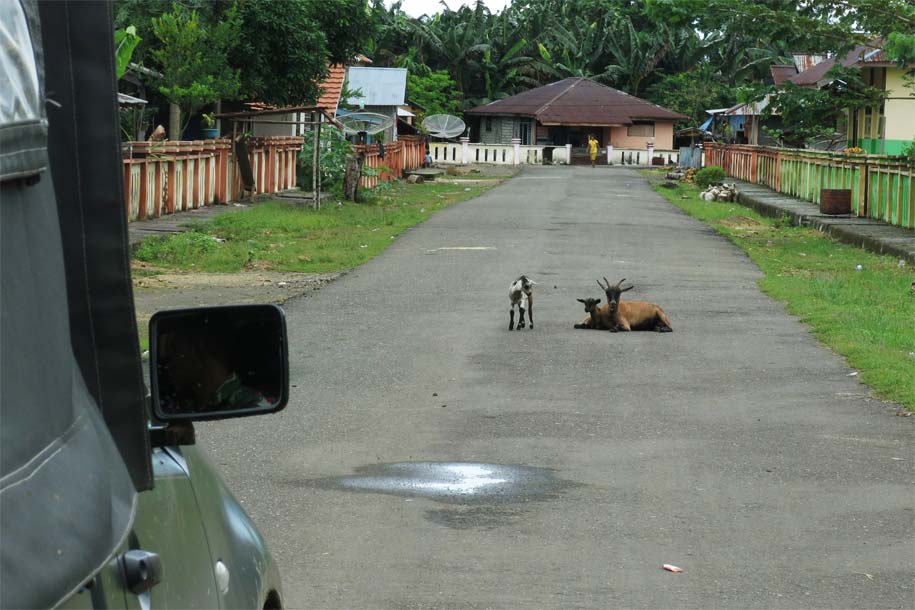Landmines in Wayabula

The neatly arranged rows of houses are a pretty sight when entering Wayabula Village. The village streets are smooth and covered in thick black asphalt. Not a few people who carve a smile to guests who come. Wayabula Village is one of the villages in West South Morotai District, Morotai Regency, North Maluku. Wayabula is located about 50 kilometers north of the capital city of Morotai, Daruba.
While enjoying the trip, suddenly the car stopped suddenly like there was an obstacle. It turned out that a herd of goats passed without hesitation on the village road. When I got out of the car, I could smell an unpleasant odor. The distinctive odor of livestock and their droppings was picked up by the nose. If you look around, there are indeed many animals left unattended by their owners.
Goats, cows, chickens, and dogs are the most common animals in Wayabula. Some animals are tied up, but many are left free. When walking on the streets of the village, one must keep their eyes peeled for landmines. The head of Wayabula Village, Alimin Mansur, has reminded his residents several times not to let their pets roam the streets.
“We have reminded the community, so the animals must be in cages. But sometimes we have repeatedly told the community, they just leave it like that,” said Alimin when met at his house.
Alimin emphasized that the village government plans to impose sanctions if people are still stubborn. According to him, pets that are left loose can disturb the comfort of the village. People crossing the road can be hampered by the animal. Not to mention the added animal feces that cause unpleasant odors.
Wayyama Wabula, head of the Wayabula Community Health Center, said he has collaborated with the local Livestock Service Office to socialize to the community about pets. “There has been counseling but the community has not realized it,” Wayyama said.
It is no secret that animals can also transmit diseases to humans. The transmission of disease or infection from animals to humans is known as Zoonosis. The Journal of Agricultural Research and Development by the Agricultural Technology Assessment Center, classifies zoonosis from its causes. Zoonoses are caused by four factors including bacteria, viruses, parasites and fungi.
Zoonoses can be transmitted from animals to humans in several ways. The first is direct contact with animals with zoonoses. Second, indirect contact, such as eating food made from animals with zoonoses. Third, through air polluted by bacteria or viruses from animals with zoonoses.
Animals released in the Wayabula Village environment certainly have the potential to transmit zoonoses. Animal feces and direct contact with the owner become the medium for Zoonosis. Efforts to prevent zoonoses are to increase the knowledge, awareness and concern of the community itself. People can start by housing and maintaining pet hygiene.
Caging pets can make it easier for owners to control and care for the animals. Occasionally, animals can be released in certain areas other than residential areas. Feeding can also be adjusted, so that animals do not pick up food carelessly. Cage cleanliness also needs to be cleaned regularly. Disinfectant spraying is also necessary to prevent infection and pollution from bacteria, viruses and germs.
Utilization of Livestock Manure
Some types of animal waste can be reused, especially manure from livestock. The most common uses of livestock manure are for fertilizer and biogas. Processing manure into fertilizer can be the selling point of the manure. Fertilizer from manure can be sold to people who work in the fields or in the garden. For animal owners who also have gardens, there is certainly no need to spend more to buy fertilizer.
Another utilization of animal waste is for biogas. Biogas is categorized as an alternative energy source. Researcher at the Directorate of Agroindustrial Technology and Biotechnology, Daru Mulyono, explained biogas in his scientific journal. The content of natural substances in livestock manure is used to meet energy needs. Biogas is a mixture of gases produced from the process of breaking down livestock manure by microorganisms.
The breakdown occurs in an anaerobic process or conditions without oxygen. The process of biogas formation occurs during the fermentation process of these organic materials. Biogas can be used for cooking, lighting, and other purposes that require energy.
It does take more effort to process livestock manure. But when viewed in terms of benefits, it will be much better than being wasted. Besides being good for personal health and the environment, it can also increase rupiah coffers. Don’t let these ‘landmines’ really become mines that can threaten public health.
